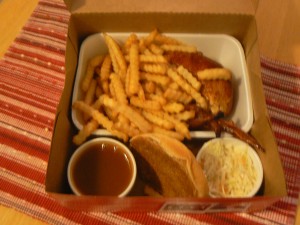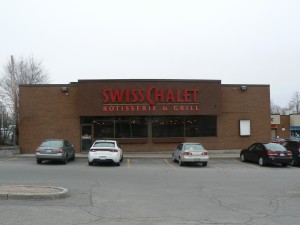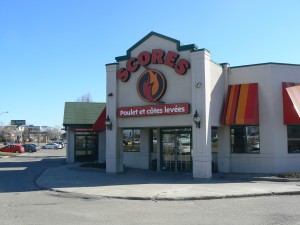Fowl situation: Canadians clucking about rotisserie chicken
Just weeks after ketchup captured national headlines, rotisserie chicken and ribs have become Canada’s latest culinary conversation. On April 1, Toronto-based Cara Operations, owner of the Swiss Chalet Rotisserie and Grill chain, announced it was taking over St. Hubert, its main chicken and rib rival, based in Laval, Quebec. Cara has no plans to re-brand the wildly successful St. Hubert chain as Swiss Chalet or change any of the food. However, Quebecers are concerned Cara is going to tinker with St. Hubert and influence it too much with Swiss Chalet—a restaurant and food most residents of La Belle Province will quickly say is inferior. The biggest difference is over which restaurant has the best dipping sauce. Swiss Chalet was a flop in Quebec and closed all of its restaurants there over a decade ago. Many Canadians outside Quebec didn’t embrace St. Hubert either. After once trying to expand across the country, the only St. Hubert locations outside Quebec are now in parts of eastern Ontario near the Quebec boundary. There’s a location in Cornwall near the bridge to Massena, NY.
St. Hubert is a huge part of Quebec’s contemporary lifestyle. It all started with one restaurant on St. Hubert Street in Montreal back in 1951, and now there are 117 locations. For chain restaurant dining, it reflects Quebec culture very well. The portions are a bit larger, the restaurants are nicely decorated, and the service is friendly. Many locations have a separate bar and lounge branded as “Le St. Hub,” and a separate children’s playroom where the kids can color and watch a continuous loop of The Flintstones dubbed into French on a television screen. Suburban couples go to the St. Hub for drinks, while families feast on tenderly succulent chicken and ribs. The dessert menu features Quebecois treats like sugar pie and pouding chomeur.

Poultry Patrol: St. Hubert delivery cars at the ready outside the restaurant in Hull. Photo by James Morgan
St. Hubert is Quebec’s patron saint of casual dining. Its goofy looking rooster sign is a beacon to famished families and hungry highway travelers. The company proudly boasts it was the first restaurant chain in Canada to offer free delivery. Orders are taken by phone and online. Every St. Hubert location has a fleet of yellow compact cars—originally they were all Volkswagen Beetles, which are dispatched from the restaurant to deliver chicken and rib dinners to wherever needed. An illuminated plastic rooster comb on the roof of the car flashes on and off while on delivery.
Swiss Chalet started on Bloor Street in Toronto back in 1954 and now there are over 200 locations across Canada. There is nothing really very Swiss about the place. At one time, the restaurants vaguely resembled a Swiss chalet architecturally. Waitresses wore dirndl-inspired uniforms, and there were pictures on the walls of alpine scenes. That all disappeared in the 1990s. There never has been any uniquely Swiss cuisine on the menu.
In many ways, Swiss Chalet embodies stereotypes of English Canada. During the 1990s and early 2000s, Swiss Chalet earned the nickname “Christian Chicken” because it had become the popular Sunday dining destination for many after church. I grew up in what could easily be called the buckle of Ontario’s Bible belt. Protestant evangelicals dominate the religious scene. I’ve heard friends and even preachers refer to Swiss Chalet as Christian Chicken. I’ve sat in a Swiss Chalet on a Sunday afternoon and overheard conversations about that morning’s sermons and hymns. There are no children’s playrooms and no separate bar and lounge. While St. Hubert has a name connected to Quebec’s Roman Catholic heritage, Swiss Chalet, with its plainer interiors, smaller portions, and Sunday clientele, is a symbol of old Ontario protestant piety.

Box of Benny: A Benny & Co. chicken breast take-out menu includes crinkle -cut fries, coleslaw, dipping sauce, and a roll. Photo by James Morgan
I occasionally meet friends at St. Hubert, especially if they’re from Ontario and curious about the phenomenon. A friend from Christian Chicken-land recently contacted me and said he and his young family will be in the area in a couple of weeks and want to try St. Hubert before Swiss Chalet changes it too much. There are also equally good smaller competitors like Benny & Co., which mostly operates take-out and delivery locations. Benny differs from St. Hubert by serving crinkle-cut fries and their own dipping sauce recipe. They also have a fleet of red hatchbacks for delivery with a flashing yellow chicken on top. A more recent arrival on the scene is Scores, which appeals to the health-conscious customer by offering a salad bar. Each of these chains has their loyal customers, but none is greater than St. Hubert’s loyalty. In Quebec, they mean business about their chicken and ribs.










